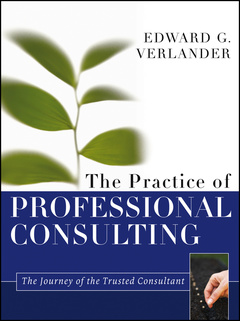Description
The Practice of Professional Consulting
Author: Verlander Edward G.
Language: English
Subject for The Practice of Professional Consulting:
320 p. · 17.8x23.4 cm · Hardback
Description
/li>Contents
/li>Biography
/li>
The Practice of Professional Coaching
Change is the life-blood of consulting just as organizations endure only through successful change. The reality of this mutual need lies at the heart of what consulting is all about. Consultants solve problems created by the powerful forces of change in an organization's environment and in so doing, create change themselves.
The Practice of Professional Consulting is a comprehensive examination of what has been called "the world's newest profession." In this practical resource Edward Verlander offers an overview of the industry and includes the most useful processes, tools, and skills used by successful consultants to produce solutions for their clients. The book also reveals why consulting is a growing and attractive career option.
The best practices used by leading consulting firms are included in the book as well as the capabilities skillful consultant use in each stage of engagement. Verlander also recommends ways to ensure a consultant can solve a client's problems in a systematic, professional way. At the very heart of the book is the emphasis he puts on what is needed to become a truly trusted consultant.
Filled with a wealth of must-have information from a wide range of consulting professionals, the book includes: a model of the consulting cycle; a diagnostic instrument for assessing consulting roles; ideas of how to develop political intelligence to navigate client organizations; tools for managing consulting meetings, risk assessment, and skills transfer; techniques in communications, emotional intelligence, presentations, and listening; and much more.
Written for anyone wishing to start a consulting business, new employees at established consulting firms, facilitators of consulting training programs, and faculty at business schools, this important resource provides an easy way to understand the stages, roles, and tasks of consulting found in any type of consulting and it provides simple and easy-to-use techniques and templates for implementation.
About This Book xii
Preface xv
Acknowledgments xviii
Part One: Setting the Stage 1
1 The Nature of Consulting 3
It’s an Industry 4
Types of Consulting 8
Scope of Consulting 10
Trusted Consultant and Advisor 12
Consultant Qualifications 14
What Is Professional Consulting? 16
2 Why Companies Hire Consultants 19
Why Consultants Are Needed 19
Fast, Bigger, Better, Cheaper Outcomes 21
Forces That Drive Business Consulting 25
Expectations of Consultant Services 30
Changes in Client’s Business and Organization Needs 31
Future Challenges 34
3 A Model for Professional Consulting 38
What Do We Mean by “Process”? 38
A Framework for Consulting 39
The Four Stages of Consulting 44
The Four Roles of Consulting 46
Consulting Competencies 48
Part Two: Applying the Model 53
4 Stage One: The Developing and Designing Process 55
Stage One Competencies: Winning the Business 56
Understanding the Client’s Business and Industry 59
Making a Good First Impression 61
First Meeting Dynamics 63
5 Stage One, Continued: Assessing Client Needs and Managing Expectations 70
The Purpose of Conducting a Needs Assessment 70
Types of Questions: The Fundamentals 72
Conducting a Needs Assessment: A Question Strategy 74
Needs Assessment: Listening Actively 79
The Proposal Development Process 82
Managing Expectations 91
6 Stage Two: The Mobilizing and Aligning Process 96
Stage Two Competencies: Mobilizing and Aligning 96
Work and Project Plan Reviews 97
Risk Assessment Factors 106
Project Launch Meetings 108
7 Stage Two, Continued: Turning a Consulting Group into a Team 116
Defining a Team 116
Stages of Team Development 119
Diagnosing Project Team Performance 121
How Team Building Is Conducted 122
Special Problems in Building Project Teams 123
Characteristics of High-Performing Teams 126
The Project Leader Style Needed for Team Building 127
8 Stage Three: The Building and Producing Process 130
Stage Three Competencies: Building and Producing 131
Data Gathering 132
Performance Management and Coaching 137
Coaching Consultants 139
Motivating Consultants 146
Progress Review Meetings 151
Navigating Organizational Politics 155
Project Management Issues 161
9 Stage Four: The Implementing and Deploying Process 168
Stage Four Competencies: Implementing and Deploying 169
Managing Change 171
Implementation Strategies 175
Skills Transfer 180
Measuring Customer Satisfaction 186
Satisfaction Assessment Metrics 190
Part Three: The Bigger Picture 195
10 Improving Consulting as a Professional Practice 197
A Reality Check About Consulting 198
The Need to Professionalize Consulting 200
Professional Capabilities of Consultants 205
Building Block One: Client’s Business Focus 208
Building Block Two: Business Management 210
Building Block Three: Technical Requirements 214
Building Block Four: Interpersonal Attributes 215
Building Block Five: Effective Leadership 217
11 Lessons of Experience 222
How to Grow in Professional Capability 223
Lessons from McKinsey 225
The Pain and Joy of a Consulting Career 227
Professional Proficiencies in Consulting 231
Trends for the Twenty-First Century 234
Appendices
A The Consulting Role Preference Indicator 238
B Guidelines for Successful Consulting 250
C The Leadership Role of Consultants 258
D Consulting Case Applications 262
E Diagnostic Procedures and Instruments for Consulting Teams 264
Bibliography and Resources 274
About the Author 280
Index 282
THE AUTHOR
Edward Verlander is chairman of Verlander, Wang & Co., LLC, an international management consulting firm that delivers services in strategy, organization change, leadership development, and executive coaching. Clients are world-wide and embrace the Fortune 500, numerous European technology companies and, most recently, the public and private education sectors in China. He also teaches MBA-level business consulting at Long Island University and has taught management at Columbia and Hofstra Universities, as well as in the business schools at Jilin University and Nanjing University in China.




